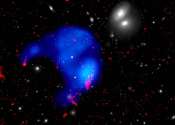Data from the Fermi Large Area Telescope suggests there is a particle accelerator in the galactic center
A team of researchers at the Chinese Academy of Sciences has found evidence of a powerful particle accelerator in the galactic center. In their paper published in the journal Nature Communications, the group describes their ...









